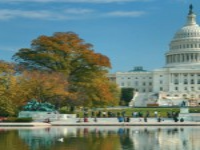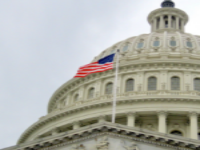Tariffs: A Jumbled Mix of Issues

The super-hot topic of tariffs received spotlight attention during AAPA’s Legislative Summit on March 18, in Washington, D.C.
The session “Mainstage Panel: Tariffs are Taxes” presented a far-reaching set of insights, comments and — most importantly — concerns regarding President Trump’s commitment to make tariffs a central US policy lever to impact trade, taxes, fentanyl and drug trafficking, steel and aluminum production, and federal revenue. The panel’s common concern: For this outsized mix of international issues, it’s hard to see how tariffs can deliver the beneficial outcomes hoped for by the president.
The Mainstage panelists included:
- Jon Gold, Vice President of Supply Chain and Customs Policy, National Retail Federation
- Dr. Noel Hacegaba, Chief Operating Officer, Port of Long Beach
- David Gutheil, Interim President & CEO/Chief Commercial Officer, Port of Cleveland
The session was moderated by Dan Ronan, News Anchor for Washington, D.C.’s WTOP News and for National Public Radio. The following is a summary of some of the top issues raised during the panel’s discussion.
Small Businesses Will Get an Outsized Hit
Dan Ronan opened the discussion with reference to the uncertainty characterizing tariff implementation and policies. One day, the tariffs are on, Ronan noted, the next day, they’re off. Similarly, they’re set at one level on one day, then the next day, it’s different.
Jon Gold commented on this, stating right away: “Tariffs are taxes.” The cost of tariffs, he said, are passed on to customers, and the money collected is paid to the government.
Gold added further that tariffs present tougher issues for small businesses compared to large businesses. Small businesses, Gold said, usually don’t have the resources, flexibility, and market scope that large businesses can draw upon. Most small businesses can’t absorb the cost of the tariffs and have no choice but to pass those costs on and hope their final price remains competitive.
Proposed Policies Aren’t Clear
Of course, it’s one thing if a policy — even an unpopular one — is straightforward, clear and unswerving. But that hardly characterizes how the 2025 tariff issues started. Tariffs were a priority in the first Trump administration, Gold noted, but he added that policies and implementation were different then: The tariffs were smaller, more targeted, and businesses had more time to prepare and to react.
Today, in contrast, Gold described the tariff debate as chaotic, with unanswered questions about additive costs, disagreement among agencies, challenges among officials and, of course, zig-zagging pronouncements that change almost daily.
During their discussion, the panelists noted, with frustration, the broad brush of issues the new tariffs are supposed to affect. Indeed, a look back at the executive orders in January and February is a clear reminder of why “tariffs” is the president’s favorite word — or, as moderated later, one of his favorite words. In January’s “America First” Trade Policy, for example, tariffs are cited as a way to correct trade imbalances. In February, it’s tariffs that would stop fentanyl and drug trafficking from Canada, Mexico, and China. Also in February, new aluminum and steel tariffs were announced to help bump up demand from U.S. producers and address unused and slack production capabilities. Ditto regarding the on-again-off-again timing — Canadian tariffs were paused, until March, two days after they were announced.
As points of national entry, coastal ports are at the tip of the spear regarding tariffs. Ronan asked Noel Hacegaba how the Port of Long Beach (POLB) was facing the new tariff policies, and how these changes are impacting port activities, especially following a very busy and successful year in 2024.

Uncertainties: Never Good for Business
For Long Beach, Hacegaba said, one early impact was a rush of shipping volumes to the Port, because shippers are trying to get ahead of the tariffs. But he cautioned: “We’ve seen this [tariff]issue before, but this is so different.” He said if Trump’s tariffs from his first administration were a movie, this new round of tariffs “should not be considered a sequel. This new movie is very different,” he commented, adding that “the stops and starts are unprecedented.”
David Gutheil from Cleveland, which is largely a breakbulk port, not a container port like POLB, said that steel imports — 40,000 to 50,000 tons/year from Canada — are a major activity at Cleveland and other Great Lakes ports. He said the tariff controversy has been “frustrating for us and the steel industry.” He, too, cited uncertainties about timing and even implementation.
He noted that tariffs will impact economic expansion and the related, necessary infrastructure projects, both for ports and for heavy industries like steel and aluminum. Policy uncertainties undermine decisions about next steps, about which road to follow, and how to plan investments and financing. If tariffs cut steel imports, that shapes infrastructure in one direction. But if tariffs are in doubt, so are future developments.
Gutheil called the tariff roll-out a “gatling gun approach” across unrelated issues. For example, he said he asked Cleveland steel producers if they can increase U.S. production by 50% in three years. Their answer: No way. “If (tariffs) are a play to improve steel making, it’s a long runway,” Gutheil commented, adding, “I can’t connect the dots to that endgame.” Similarly, if the goal is drug interdiction, he commented wryly: “I don’t think you can smuggle fentanyl in a steel coil. Maybe somebody’s figured it out, but we haven’t seen it.”
New Fees Could Skew the System
The panel’s discussion broadened, highlighting two topics: One is the support for shipbuilding that is growing across the federal sector, both within the Administration as well as Congress. The second is the intent by the U.S. Trade Representative (USTR) to place per/ton fees on Chinese vessels calling in U.S. ports.
Worth noting: Since the March 18 Mainstage discussion, this USTR fee proposal — a “Section 301 Action” in regulatory jargon — has advanced. On April 17, the USTR proposed that, starting in October, vessels used by Chinese ship operators and shipowners and operators of Chinese-built ships will be assessed a fee of $50 per net ton, estimated to add up to total fees between $1 and $1.5 million per ship. The fees will increase every six months. Then, a second phase would start in three years to:
“Incentivize U.S. built liquified natural gas (LNG) vessels, limited restrictions on transporting LNG via foreign vessels (sic). These restrictions will increase incrementally over 22 years.”
In the future, additional Chinese equipment, e.g., cranes, may be similarly assessed. In their March discussion, the panelists questioned the logic behind these moves. Jon Gold commented: “Note how the Sec. 301 text is written, it includes any Chinese vessel.”
Dave Gutheil wondered whether Canadian ships — likely built in China, given China’s dominance in international shipbuilding — could afford to sail the Great Lakes. He said the million-dollar fees will cripple the Great Lakes maritime industry. He noted that when steel comes into a port, agriculture or other products are then exported. If ships with steel don’t arrive, how will exports move out? Gutheil predicted shipping lanes will consolidate because operators will move to avoid port calls and new fees.
Hacegaba expressed concerns that port slowdowns could impact the national economy and employment. He said cargo volumes at POLB support 2.6 million jobs across the country, in all 50 states, delivering a total economic impact of $2.8 trillion.
“I like to say,” Hacegaba commented, “that the movement of goods is literally the economy in motion. So don’t slow that.” Again, with reference to shipbuilding and other social and economic goals, he expressed support for such programs. “But if the long-term play is shipbuilding,” he added, “then we need more coordination, better strategy.”

Tariffs Are Taxes
The panelists discussed the possibility that revenue from tariffs and Chinese vessel fees could pay for new programs, e.g., to support the president’s goals to expand maritime cargo and expand U.S. shipbuilding. Are the tariffs primarily a way to raise revenue, Ronan asked at the start of this discussion, possibly to pay for upcoming tax cuts?
Gold answered directly: “Yes, tariffs will raise money from every U.S. individual,” including from low-income people who normally don’t pay federal taxes. Ronan asked further: Then it will be 340 million U.S. citizens paying the tariffs? That’s correct, Gold replied, American customers will pay, not people overseas. Gold noted additional, early discussions from the Trump Administration about an “external revenue service” that might be established to oversee tariff revenue and expenditures, an idea possibly linked to tax cuts. But there are no details or clarity yet on those ideas, Gold said, with reference again to the jumbled context of the overall tariff rollout.
During an audience Q&A session, an audience member asked about the questions port customers are asking port officials and what kind of activities, at least in response to the tariffs, those customers are seeking?
Hacegaba said, yes, POLB officials get many questions. Their frequent reply: “We’re all trying to make sense of this.” He commented that events such as this discussion are important for seeking clarity and sharing ideas.
Dave Gutheil agreed. “We’re all talking about it,” he said, and added that “most of the questions we’re getting are from FTZs” (foreign trade zones). In the U.S., FTZs have an international standing, offering a location where goods handled solely for export can take advantage of certain allowances regarding taxes and fees and tariffs. FTZs are important economic development tools used across the country, not just in maritime port cities.
In their discussion about broader issues that might be linked to tariffs and new initiatives, workforce recruitment and development was one of the top priorities. Workforce challenges are critical across many sectors, the panelists said, from steelmaking to construction to expanded maritime and cargo operations, and, of course, for ports.
“We need labor,” Gutheil comment. Gold added that the U.S. economy is very productive, with domestic manufacturing at an historic high. “But we need upskilling,” he noted, again commenting that these various issues will not be solved by tariffs, at least as such issues have been associated with tariffs so far.
Both Hacegaba and Gutheil did draw attention to high schools in their cities, with a focus on maritime issues. Hacegaba referenced the High School of Global Logistics, in Long Beach, which introduces maritime careers to students. Gutheil mentioned the Davis Aerospace & Maritime High School, part of Cleveland, Ohio’s public school system. Davis hosts the marine-focused Argonaut program which, Gutheil said, is already connecting students with Great Lakes shippers.
As the session drew to a close, Ronan asked: How will this end? No one jumped out with an easy answer. Gold noted support, from many sectors, for policies that will revitalize the economy, take on bad actors and help with tax reform. “But tariffs won’t help us get to those endpoints,” he said.



